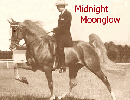| | | The Tennessee Walking Horse performs the flat foot walk, running walk, and canter. These are the three gaits for which the Tennessee Walking Horse is famous, with the running walk being an inherited natural gait unique to this breed. The Tennessee Walking Horse will also call upon it's racing blood and do a smooth, fast gallop, if you need to get somewhere or catch something. | 2010 World Equestrian Games
Tennessee Walking Horse Breed Demonstration
Scot and Lynn MacGregor on Banner's Dixie Belle and Cash's Prime Time. | | Many Tennessee Walking Horses are able to perform the rack, stepping pace, fox-trot, single-foot and other variations of the famous running walk. While this is not desirable in the show ring, the above mentioned gaits are smooth easy trail riding gaits. | | THE FLAT WALK |  | The flat foot walk is a brisk, long-reaching walk that can cover from 4 to 8 miles an hour. This is a four cornered gait with each of the horse's feet hitting the ground separately at regular intervals. The horse will glide over the track left by the front foot with his hind foot (right rear over right front, left rear over left front). The action of the back foot slipping over the front track is known as over-stride. | | Over-stride is unique to the walking horse breed. The hock should show only forward motion, with vertical hock action being highly undesirable. A Tennessee Walking Horse will nod its head in rhythm with the cadence of its feet. This nodding head motion, with the over-stride, are two features that are unique to the Tennessee Walking Horse. This unique head motion along with over-stride are the two main things the judge should take into consideration when judging a Tennessee Walking Horse. | | | | | THE RUNNING WALK | | The running walk is the gait for which the walking horse is most noted!
This extra-smooth gliding gait is basically the same as the flat walk with a marked increase in speed. This breed can travel 10 to 20 miles per hour at this gait. As the speed is increased, the horse over-steps the front track with the back foot by from 6 to 18 inches. The more "stride" the horse has, the better "walker" it is considered to be, for this gives the rider a feeling of gliding through the air as if propelled by some powerful but smooth-running machine. |  | | Since their gaits are easy for them to perform, Walking Horses relax certain muscles while doing the running-walk; some nod their heads in rhythmic timing, swing their ears in perfect motion, and some even snap their teeth. The running walk is a smooth, easy gait for both horse and rider. It is basically the same gait as the flat walk, with an increase in speed, and length of stride. There should be a noticeable difference in the rate of speed between the flat walk and the running walk, but a good running walk should never allow proper form to be sacrificed for excessive speed. A true Tennessee Walking Horse will continue to nod while performing the running walk. Judging should not be influenced by speed, but rather by the true form exhibited. | | | THE CANTER |  | The third gait is the canter, which is a collected gallop. The canter is performed in much the same way as other breeds, but the walking horse seems to have a more relaxed way of performing this gait. The canter is a forward movement performed in a diagonal manner to the right or to the left. On the right lead, the horse should start the gait in this order: left hind, right hind and left fore together-then right fore. The order for the left lead is: right hind, left hind and right fore, then left fore. | | When performed in a ring, the animal should lead his canter with the fore leg to the inside of the ring. In the canter, the horse gives a rider an easy rolling motion with lots of spring and rhythm, that is likened to a rocking chair. This is often referred to as the "rocking-chair-gait". | |
| | | |

